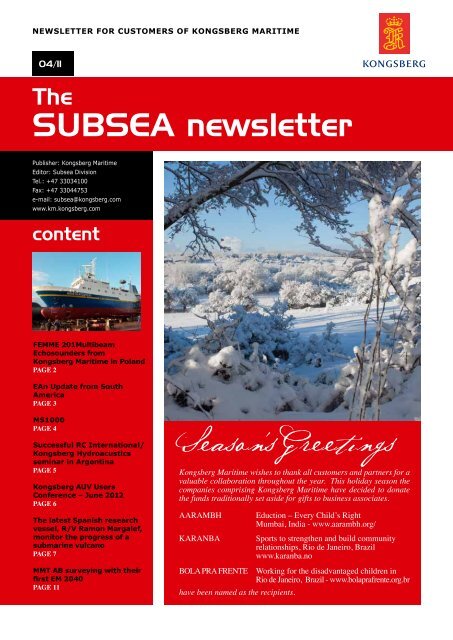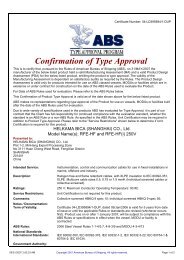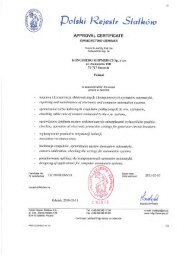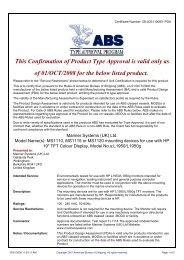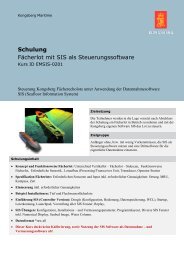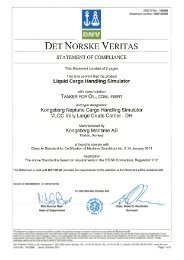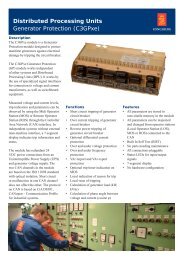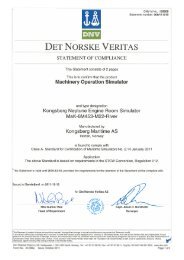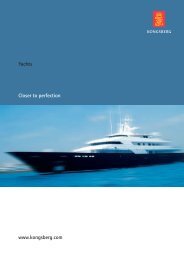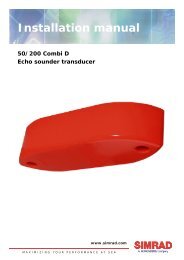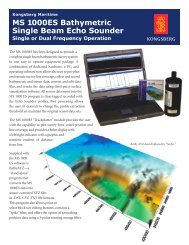No. 4 - December 2011 - Kongsberg Maritime
No. 4 - December 2011 - Kongsberg Maritime
No. 4 - December 2011 - Kongsberg Maritime
You also want an ePaper? Increase the reach of your titles
YUMPU automatically turns print PDFs into web optimized ePapers that Google loves.
NEWSLETTER For customers of kongsberg MARITIME<br />
04/11<br />
The<br />
SUBSEA newsletter<br />
Publisher: <strong>Kongsberg</strong> <strong>Maritime</strong><br />
Editor: Subsea Division<br />
Tel.: +47 33034100<br />
Fax: +47 33044753<br />
e-mail: subsea@kongsberg.com<br />
www.km.kongsberg.com<br />
content<br />
FEMME 201Multibeam<br />
Echosounders from<br />
<strong>Kongsberg</strong> <strong>Maritime</strong> in Poland<br />
PAGE 2<br />
EAn Update from South<br />
America<br />
PAGE 3<br />
MS1000<br />
PAGE 4<br />
Successful RC International/<br />
<strong>Kongsberg</strong> Hydroacustics<br />
seminar in Argentina<br />
PAGE 5<br />
<strong>Kongsberg</strong> AUV Users<br />
Conference – June 2012<br />
PAGE 6<br />
The latest Spanish research<br />
vessel, R/V Ramon Margalef,<br />
monitor the progress of a<br />
submarine vulcano<br />
PAGE 7<br />
MMT AB surveying with their<br />
first EM 2040<br />
PAGE 11<br />
S e a s on’sG re e t in g s<br />
<strong>Kongsberg</strong> <strong>Maritime</strong> wishes to thank all customers and partners for a<br />
valuable collaboration throughout the year. This holiday season the<br />
companies comprising <strong>Kongsberg</strong> <strong>Maritime</strong> have decided to donate<br />
the funds traditionally set aside for gifts to business associates.<br />
Aarambh<br />
Karanba<br />
Eduction – Every Child’s Right<br />
mumbai, India - www.aarambh.org/<br />
Sports to strengthen and build community<br />
relationships, Rio de Janeiro, Brazil<br />
www.karanba.no<br />
Bola Pra Frente Working for the disadvantaged children in<br />
rio de Janeiro, Brazil - www.bolaprafrente.org.br<br />
have been named as the recipients.
The SUBSEA NEWSLETTER page 2<br />
DECEMBER <strong>2011</strong><br />
Successful product<br />
seminar in Spain<br />
Multibeam Echosounders from<br />
<strong>Kongsberg</strong> <strong>Maritime</strong> in Poland<br />
Part of the <strong>Kongsberg</strong> <strong>Maritime</strong> sales<br />
team who carried out the presentations.<br />
On September 13th and 15th, two<br />
seminars for <strong>Kongsberg</strong> <strong>Maritime</strong><br />
Subsea products were given in Madrid<br />
and Cádiz respectively.<br />
The first, held at the Hotel AC Carlton<br />
in Madrid, consisted of several<br />
system presentations and was wellreceived<br />
by well-known customers<br />
and other companies with important<br />
projects in progress.<br />
In Cádiz, the seminar was held in<br />
Baluarte de los Mártires, located in<br />
the old headquarter of the city just<br />
on the seaside, which was a fortress<br />
part of the fence wall around Cádiz<br />
city. The grand building featured a<br />
huge conference room able to hold<br />
a large audience and a nice terrace<br />
overlooking the sea.<br />
Attendees were able to see the wide<br />
range of systems with a common<br />
technology root based on extensive<br />
experience and reputation from<br />
<strong>Kongsberg</strong> <strong>Maritime</strong>.<br />
It was a comprehensive agenda that<br />
included the following updates:<br />
• Hydrography, Multibeam and<br />
Singlebeam echosounder, side scan<br />
sonars, sub-bottom profiler and<br />
other bathymetric sonars.<br />
• Acoustic Instrumentations with<br />
the new positioning systems.<br />
• Cameras and scanning sonars.<br />
• Autonomous Underwater<br />
Vehicles - AUV´s families.<br />
• Reference and motions systems.<br />
In addition a special presentation<br />
was held, describing <strong>Kongsberg</strong><br />
<strong>Maritime</strong>’s capabilitieson doing<br />
projects integrating the groups<br />
whole product range. Examples<br />
from latest projects was given.<br />
NAWIGATOR XXI, a training vessel<br />
owned by <strong>Maritime</strong> University in Szczecin,<br />
has been equipped with the first<br />
multibeam echosounder EM 710 in Poland,<br />
capable of operating at the depths<br />
of up to 2000m.<br />
The echosounder has been delivered<br />
and installed by Escort Ltd and the final<br />
stage of installing the transducers<br />
was conducted by Mr Terje Moe and<br />
Mr Jørgen Hamre, representatives from<br />
<strong>Kongsberg</strong> Company. Transducers Tx<br />
and Rx were mounted at the bow of the<br />
vessel during its stay at dry dock in Szczecin<br />
Ship Repair Yard ’Gryfia’. The<br />
installation of the whole system took<br />
place in September <strong>2011</strong>.<br />
In the first week of October, a five-day<br />
long sea trial was carried out on the Baltic<br />
Sea. The trials and calibration of the<br />
system culminated successfully and the<br />
system worked very well, even during<br />
rough weather conditions.<br />
The installation of the transducer at the<br />
bulbous bow as a result gave very good<br />
acoustic conditions for operation of the<br />
system. This mounting spot was proposed<br />
by Mr Bjorn Hoyum Larsen during<br />
his visit to Szczecin in August. At<br />
that time, a few various other mounting<br />
spots were considered. One of mounting<br />
option was on the gondola under<br />
the vessels hull, which, was rejected as<br />
it would change the parameters of the<br />
vessel’s submersion and increase the installation<br />
costs. The ship owner wanted<br />
to avoid such a situation. The technical<br />
documentation regarding transducers’<br />
installation was prepared by the MID-<br />
CON – the Designe Office, while the<br />
documentation of electrical installation<br />
was prepared by Escort Ltd.<br />
At present, <strong>Maritime</strong> University also<br />
owns the GeoSwath Plus 250 kHz multibeam<br />
echosounder, which is installed<br />
on HYDROGRAF XXI - another small<br />
training vessel.<br />
Moreover, the <strong>Maritime</strong> Office in Szczecin<br />
owns two EM 3002D systems and<br />
the Hydrography Office of the Polish<br />
Navy in Gdynia has two EM 3002D systems<br />
as well. The Port Authority Gdansk<br />
also has one EM3002S system and<br />
a very similar one is owned by Gdańsk<br />
University of Technology. In <strong>December</strong><br />
<strong>2011</strong>, another GeoSwath Plus 500 kHz<br />
system will be delivered to the Hydrographic<br />
Office of the Polish Navy in<br />
Gdynia.
The SUBSEA NEWSLETTER page 3<br />
DECEMBER <strong>2011</strong><br />
NOAA and Partners demonstrated success of<br />
EM 302 Multibeam Echosounder to detect and<br />
map deep-sea gas seeps<br />
knowledge of the marine environment,<br />
including the distribution of natural<br />
sources of methane input into the ocean<br />
and the identification of communities of<br />
life that are often associated with methane<br />
gas seeps,” said Thomas Weber, Ph.D., of<br />
the University of New Hampshire’s Center<br />
for Coastal and Ocean Mapping and<br />
lead scientist of the mission.<br />
Multibeam sonar, an echo sounding<br />
technology commonly used to map the<br />
seafloor, can also be used to map and detect<br />
gaseous seeps in the water column,<br />
according to scientists testing the technology<br />
on board NOAA Ship Okeanos<br />
Explorer in the Gulf of Mexico.<br />
Following an earlier test in 2009 on<br />
Okeanos Explorer’s multibeam sonar<br />
off the U.S. West Coast, the most recent<br />
expedition in the Gulf was the first comprehensive<br />
test of Okeanos Explorer’s<br />
multibeam to detect deep gaseous seeps<br />
over a wide area. Its use during this mission<br />
confirms the effectiveness of the<br />
tool and may lead to extending NOAA’s<br />
water-column mapping capabilities.<br />
The expedition was conducted jointly<br />
by NOAA’s Office of Ocean Exploration<br />
and Research (OER), the University<br />
of New Hampshire’s Center for Coastal<br />
and Ocean Mapping and the Bureau of<br />
Ocean Energy Management, Regulation<br />
and Enforcement (BOEMRE), as well as<br />
scientists and technicians from NOAA’s<br />
Southeast Fisheries Science Center working<br />
in parallel from NOAA Ship Pisces.<br />
With the Gulf of Mexico home to numerous<br />
gaseous seeps, data collected by<br />
multibeam sonar could prove valuable to<br />
researchers planning further studies of<br />
gas seeps and their effects on the marine<br />
environment.<br />
The objective of the expedition was to<br />
test the sonar’s ability to map gaseous<br />
seeps, not oil, as oil is more difficult to<br />
acoustically detect with the multibeam<br />
sonar. Techniques developed during<br />
this cruise are intended to help scientists<br />
better understand detection of gas<br />
seeps which may in turn better inform<br />
scientists who are working on techniques<br />
to map oil in the water column.<br />
“This capability will help increase our<br />
“Mapping the seafloor and the water<br />
column are essential first steps in exploring<br />
our largely unknown ocean.<br />
This expedition confirms earlier indications<br />
that multibeam technology provides<br />
a valuable new tool in the inventory<br />
to detect plumes of gas in the water<br />
column, and especially in deep water,”<br />
added Weber.<br />
Bill Shedd, a BOEMRE geophysicist<br />
and expert in hydrocarbon seeps who<br />
participated in the expedition as part of<br />
an ongoing collaboration with NOAA’s<br />
OER, stated, “Our agencies have been<br />
working together in the Gulf of Mexico<br />
since 2003. We’re optimistic and impressed<br />
about this new capability for<br />
exploration that was demonstrated so<br />
well during this expedition.”<br />
An Update from South America<br />
Chile<br />
<strong>Kongsberg</strong> Maritme AS Hydrographic Departement has been awarded a<br />
contract by the Chilean Hydrographic and Oceanographic Service (SHOA) for<br />
the supply of new survey equipment for the hydrographic survey vessel PSH<br />
Cabrales. The supply consists of one EM 3002 Dual, one EM 710 1x2 one<br />
EA 400, sensors, spareparts and services. The plan is to have the equipment<br />
delivered and installed during the first half of 2012. We previously supplied<br />
EM 3002 systems to two of SHOA’s other vessels, the PSG Micalvi and PSG<br />
Ortiz, which are both in operation.<br />
Peru<br />
<strong>Kongsberg</strong> Maritme AS Hydrographic Departement has been awarded a<br />
contract by the Hydrographic Office in Callao, Lima, Peru (Direccion de<br />
Hidrografia y Navigacion - DHN) for the supply of one EM 3002 Dual, one<br />
Seapath 330, sensors and services. The equipment will be used for shallow<br />
water mapping and mapping of rivers and waterways. The system will be<br />
installed on DHN’s new shallow water survey vessel during the last part of<br />
<strong>2011</strong> and first half of 2012.
The SUBSEA NEWSLETTER page 4<br />
DECEMBER <strong>2011</strong><br />
Unique Antique for<br />
the Hydrographic<br />
Institute Museum<br />
in Cádiz<br />
MS1000<br />
Remote TS Pte Ltd, a Singapore-based inspection and survey company,<br />
were contracted to provide overview images of a wellhead<br />
template, prior to removal and after the wellheads and template<br />
had been removed. The only solution was to use the KONGSBERG<br />
MS1000 Imaging Sonar to take a number of images and then stitch<br />
them together to form a mosaic.<br />
Donation ceremony: Jan Haug Kristensen<br />
representing <strong>Kongsberg</strong> <strong>Maritime</strong> is<br />
handing over the instrument to Chief<br />
Commander Moreu from Hydrographic<br />
Institute in Cadiz.<br />
In connection with the <strong>Kongsberg</strong> <strong>Maritime</strong><br />
Subsea product seminar in Cádiz<br />
on September 15th, Simrad Spain and<br />
<strong>Kongsberg</strong> <strong>Maritime</strong> Subsea took the<br />
opportunity to donate an antique navigation<br />
instrument to the Hydrographic<br />
Museum in Cádiz, administrated by the<br />
Hydrographic Institute.<br />
This antique navigation instrument is<br />
a Graphometer double telescope with<br />
compass from 1771 built by Meurand<br />
- Quai del Horloge - Paris. This instrument,<br />
preserved in an excellent condition,<br />
is a unique and historical article<br />
for the museum’s unique collection of<br />
items related to the history of hydrography.<br />
The Graphometer was used for<br />
topographic and cartographic applications<br />
on azimuthal and vertical angle<br />
measurements.<br />
The donation ceremony took place at<br />
the Hydrographic Museum building in<br />
Cádiz, and the Hydrographic Institute<br />
Director, Chief Commander Guillermo<br />
Moreu, accepted the donation on behalf<br />
of the museum. The ceremony was<br />
attended by key people from the Hydrographic<br />
Institute together with the<br />
<strong>Kongsberg</strong> <strong>Maritime</strong> Subsea sales team<br />
who participated in the product seminar.<br />
A guided tour in the museum was<br />
also arranged to view the unique collection<br />
of hydrographic history.<br />
The equipment was deployed on the vessel<br />
and excellent images were obtained<br />
that were post processed using GIMP<br />
software into a mosaic showing the ‘as<br />
found’ and ‘as left’ condition of the site.<br />
The operators of the equipment found it<br />
very easy to set up and acquire the images.<br />
The equipment was deployed using<br />
a tripod arrangement manufactured<br />
for this particular project. The tripod<br />
and sonar head were deployed by hand<br />
to a depth of 65 metres. This arrangement<br />
worked for this project but a more<br />
robust deployment system is being designed<br />
to enable us to work at greater<br />
depths and currents. The system was<br />
also fitted to an ROV as an alternative<br />
deployment method. However, the ROV<br />
was used for other tasks and so the hand<br />
deployment method was used in this<br />
case.<br />
The client was extremely happy with the<br />
results and we look forward to carrying<br />
out similar work with them in the future.<br />
The company is actively looking for<br />
other projects using the MS1000 both<br />
offshore in the Oil and Gas industry and<br />
for onshore civil inspection projects.<br />
Roddy Macdonald, Managing Director,<br />
Remote TS Pte Ltd, said: “We are very<br />
grateful to Grant Rawlinson at <strong>Kongsberg</strong><br />
<strong>Maritime</strong> Pte Ltd, Singapore, for<br />
all the assistance received to successfully<br />
complete this project. For us, this was<br />
a new way of carrying out inspection<br />
and we were very encouraged by the<br />
results and are looking to expand our<br />
capability with the MS1000 as I think<br />
it has great potential in many different<br />
markets.”
The SUBSEA NEWSLETTER page 5<br />
DECEMBER <strong>2011</strong><br />
Successful RC International/<strong>Kongsberg</strong><br />
Hydroacustics seminar in Argentina<br />
On October 11th <strong>2011</strong>, RC International<br />
(<strong>Kongsberg</strong> <strong>Maritime</strong>’s representative<br />
in Argentina) and <strong>Kongsberg</strong> <strong>Maritime</strong><br />
Subsea Division successfully arranged a<br />
Hydroacoustics seminar in Buenos Aires,<br />
Argentina.<br />
The goal was to update all customers<br />
about the latest <strong>Kongsberg</strong> <strong>Maritime</strong><br />
Presenters on hand to guide delegates<br />
through the technology and results were;<br />
Finn Otto Sanne, Product Manager Motion<br />
Sensors at <strong>Kongsberg</strong> Seatex; Ralf<br />
Timm, Vice President Sales at Geosented<br />
all <strong>Kongsberg</strong> <strong>Maritime</strong> subsea<br />
products. Alan Rozenblum and Hernan<br />
Patrich, from RC International hosted the<br />
seminar and presented Seatex products.<br />
“The goal was to gather the key players<br />
from the industry in one room and show<br />
<strong>Kongsberg</strong>’s commitment towards our<br />
market. It’s a growing market in Argentina<br />
with a many challenges, so we need<br />
to position ourselves in the customer’s<br />
head so that when the budget increases,<br />
they will come to us,” said Alan Rozenblum,<br />
Director of RC International.<br />
Ing. Hernán Patrich Cohen of RC International,<br />
commented on the high attendance:<br />
“There aren’t many seminars<br />
on hydroacoustics in Argentina, and we<br />
usually have to travel many miles to<br />
be part of them, so when we have the<br />
chance to attend this kind of presentations<br />
in our own country, we don’t miss<br />
the opportunity.”<br />
<strong>Kongsberg</strong> <strong>Maritime</strong> Ltd Hosts Successful<br />
Subsea Seminar in Aberdeen<br />
Aberdeen-based <strong>Kongsberg</strong> <strong>Maritime</strong><br />
Ltd host the <strong>Kongsberg</strong> <strong>Maritime</strong><br />
Subsea Seminar <strong>2011</strong>, which featured<br />
presenters from across the <strong>Kongsberg</strong><br />
Subsea product groups and attracted<br />
almost 80 people from across the UK<br />
survey market.<br />
The theme of this year’s event was ‘Integrating<br />
a New Generation of Technology’<br />
and presentations focussed both on new<br />
developments in <strong>Kongsberg</strong> equipment<br />
and the integration of this technology with<br />
other products to achieve the best results.<br />
The presentations were mostly application<br />
technology and its applications.<br />
The seminar gathered around 100 participants<br />
from all sectors: Hydrographic<br />
Services, Oil Companies, Navy, private<br />
survey companies, Coast Guard, Research<br />
Institutes, marine contractors<br />
and technical support agents.<br />
KM Subsea sales team Americas preorientated,<br />
with data and conclusions from<br />
recent successful projects interspersed<br />
throughout the talks.<br />
The event was a big success and an ideal<br />
setting to showcase the latest technologies<br />
to existing and potential customers.<br />
With a large number of key customers<br />
opting to attend, it also proved a great<br />
networking opportunity. The aim of the<br />
seminar was to not only present new<br />
products and technology to customers,<br />
but to also present new ways of utilising<br />
<strong>Kongsberg</strong> technology. By enhancing<br />
the technical and practical knowledge<br />
amongst companies and individuals,<br />
this will ensure that users are maximising<br />
productivity of the equipment they<br />
have invested in.<br />
acoustics; Berit Horvei, Product Manager<br />
Multibeam; Craig Wallace, Senior<br />
Subsea Engineer; Ian Florence, Subsea<br />
Acoustic Specialist; Jan Erik Faugstadmo,<br />
Vice President UNAV, and Einar<br />
Gustafson, Sales Manager AUV.<br />
In addition, there was also various operational<br />
equipment and models on<br />
hand which provided a visual and practical<br />
element to proceedings. Working<br />
equipment included a HiPAP 351, cPAP,<br />
c<strong>No</strong>de Maxi and c<strong>No</strong>de Mini. Multibeam<br />
software SIS was also set up on<br />
replay mode showing data captured during<br />
a recent project. Models on show included<br />
a HiPAP 500, EM 2040, full-size<br />
REMUS 100 AUV model and a scaled<br />
version of the HUGIN 3000 AUV.<br />
The <strong>Kongsberg</strong> <strong>Maritime</strong> Subsea Seminar<br />
also saw the unveiling of the new<br />
<strong>Kongsberg</strong> <strong>Maritime</strong> T-shirt design,<br />
created exclusively for <strong>Kongsberg</strong> by<br />
Ian Florence.
The SUBSEA NEWSLETTER page 6<br />
DECEMBER <strong>2011</strong><br />
<strong>Kongsberg</strong> AUV Users Conference – June 2012<br />
The <strong>Kongsberg</strong> Group is pleased<br />
to announce the second REMUS/<br />
HUGIN AUV Users Conference is to<br />
be held the week of June 25, 2012 at<br />
the Villa Marigola in La Spezia, Italy.<br />
This conference will provide a forum<br />
for the worldwide REMUS and<br />
HUGIN community to come together,<br />
share ideas, experiences, learn about<br />
new developments, applications and<br />
capabilities for your AUVs.<br />
You will find more information on how<br />
to sign up for this event on our webpage<br />
in January 2012.<br />
http://www.km.kongsberg.com/ under<br />
news, events.<br />
If you are interested in reserving your<br />
place for this event, or need more<br />
information, please send an email with<br />
your name and contact information to:<br />
epatton@hydroid.com.<br />
FUGRO, <strong>Kongsberg</strong> AUV and Hydrographic<br />
teams climbing to the top<br />
Left to right: Henning Tolleifsen, Mr John McGregor (Fugro)<br />
and Mr Frank Wilhelmsen on the summit of Mt Kinabalu<br />
A joint team from FUGRO Survey Pte<br />
Ltd, Singapore, and <strong>Kongsberg</strong> <strong>Maritime</strong>’s<br />
Subsea departments in Horten and<br />
Singapore, travelled to Sabah, East<br />
Malaysia to make an attempt to climb<br />
South East Asia’s highest mountain. At<br />
4,098m above sea-level, Mount Kinabalu<br />
is known locally as ‘The revered place<br />
of the dead’.<br />
The climb took 2 days. The team started<br />
at an altitude of 1,800m on day one.<br />
A stiff climb up a rocky path through<br />
the many different layers of mountain<br />
vegetation, ensued. Finally after an<br />
exhausting 6 hours the climbers reached<br />
the sanctuary of the Pendant hut at 3,290<br />
m, and could rest and rehydrate. At this<br />
elevation the climbers were starting to<br />
feel the effects of<br />
the altitude and the<br />
reduced oxygen. After<br />
a brief few hours’<br />
sleep, they woke at<br />
1:00AM and geared<br />
up to make the final<br />
push for the summit.<br />
The mountain gods<br />
were happy on this<br />
morning, the weather<br />
was crisp and cold but<br />
beautifully still with<br />
almost no wind – perfect<br />
climbing conditions.<br />
The climbing immediately got steeper.<br />
With head torches fixed to their foreheads,<br />
using the fixed ropes for safety,<br />
they slowly climbed higher up the<br />
granite fortress of Mt Kinabalu’s summit<br />
cone. With every 100m ascent, the<br />
climbers felt the effects of the reduced<br />
oxygen more and more. With screaming<br />
lungs and burning legs it was with immense<br />
relief that they finally reached the<br />
summit at 6:40AM. Just in time to see<br />
the morning sky erupt in light and one<br />
of the most incredible sunrises unfold<br />
before their eyes.<br />
Getting to the summit of a mountain is<br />
only halfway. The team chose to descend<br />
by the ‘Via Ferrata’ route, back down<br />
to Pendant Hut. The Via Ferrata leads<br />
you, literally, straight down a cliff face.<br />
Using holds bolted into the cliff face, and<br />
taking extreme care to ensure they were<br />
always connected to the safety lines,<br />
the team slowly inched their way down<br />
the steep exposed rock for 1.5 hours.<br />
After arriving back safely at the hut and<br />
a short stop for a well-earned breakfast,<br />
a brutal knee jerking 4 hours of descent<br />
down steep steps to the base of the climb<br />
followed. A tired but happy group of<br />
climbers finally arrived back safely in<br />
the township ok Kota Kinabalu at 6PM<br />
that night to celebrate the climb.<br />
The trip was a success in many ways.<br />
<strong>No</strong>t only in that all climbers made it to<br />
the summit and down safely, but also<br />
in the relationships that formed during<br />
the journey. John McGregor from Fugro<br />
states: “It was good to get out of<br />
the office environment and spend time<br />
getting to know each other a little better<br />
in a situation that, with the exception<br />
of Grant Rawlinson, was completely new<br />
to us. The weekend was challenging, enjoyable<br />
and there was great camaraderie,<br />
all of which contributed to us gaining a<br />
much better understanding of each other,<br />
both in a personal sense and a corporate<br />
sense. It’s always easier to communicate<br />
in business if you have this extra level of<br />
understanding. This will definitely help<br />
with future communication between our<br />
two companies, particularly when it involves<br />
technical subjects.”
The SUBSEA NEWSLETTER page 7<br />
DECEMBER <strong>2011</strong><br />
The 100th EM 710 to be<br />
delivered to R/V Kilo Moana of<br />
University of Hawaii<br />
Francisco J. Gutierrez<br />
joins GeoAcoustics as<br />
Product Manager<br />
Courtesy of “R David Beales, University of Hawaii Creative Services”.<br />
Since their introduction 25 years ago,<br />
<strong>Kongsberg</strong> <strong>Maritime</strong> shallow/medium<br />
water multibeam echosounder systems<br />
have been very successful in the market.<br />
The first system, EM 100, began operations<br />
in the <strong>No</strong>rth Sea in 1986. Over the<br />
years, <strong>Kongsberg</strong> <strong>Maritime</strong> has continuously<br />
worked to develop systems with<br />
even better capabilities and subsequently<br />
released the EM 1000 in 1991 and the<br />
EM 1002 in 1998. More than one hundred<br />
EM 100/1000/1002 systems were<br />
delivered from 1986 to 2007.<br />
The EM 710 was introduced to the market<br />
during the fall of 2004 to replace the<br />
EM 1002. This system was a major leap<br />
forward in technology, incorporating<br />
many new features such as frequency<br />
modulated transmit pulses, dual swath<br />
per ping and multiple transmit sectors.<br />
The first EM 710 was delivered to the<br />
UK Royal Navy and installed onboard<br />
the HMS Endurance, the UK Navy’s ice<br />
inspection vessel for the Southern Seas,<br />
and completed successful sea trials in<br />
April 2005. As with its predecessors, the<br />
EM 710 has been highly successful and<br />
is currently in operation in more than 25<br />
countries around the world.<br />
<strong>Kongsberg</strong> <strong>Maritime</strong> is very proud to announce<br />
a new contract for the purchase<br />
of our 100th EM 710 system. The contracted<br />
unit has a 1x1 degree transducer<br />
configuration and will replace the existing<br />
EM 1002 onboard the University of<br />
Hawaii’s (UH) R/V Kilo Moana.<br />
R/V Kilo Moana is operated by University<br />
of Hawaii’s School of Ocean and<br />
Earth Science and Technology (SOEST).<br />
Established in 1988, SOEST has since<br />
grown to employ over 900 scientists,<br />
staff and graduate assistants. It is an international<br />
leader in such diverse fields<br />
as alternative energy, tropical meteorology,<br />
coral reef ecosystems, volcanology,<br />
seafloor processes, climate modeling<br />
and ocean mapping research, just to<br />
name a few.<br />
The Kilo Moana, which means “oceanographer”<br />
in Hawaiian, supports a variety<br />
of coastal and open ocean science<br />
activities for UH and other U.S. and<br />
international institutions. The ship has<br />
a unique Small Waterplane Area Twin<br />
Hull (SWATH) design, which provides<br />
a comfortable, stable platform and no<br />
acoustic noise from bubble draw-down,<br />
even in high sea conditions. The ship has<br />
dynamic positioning and two multibeam<br />
echosounders – one low frequency system<br />
for deep-water seafloor mapping<br />
and one medium frequency system for<br />
medium and shallow-water seafloor<br />
mapping. The medium frequency multibeam<br />
is scheduled to be replaced with<br />
EM 710 <strong>No</strong>. 100 during the ship’s next<br />
dry-docking period, which is scheduled<br />
for February 2012.<br />
On 1 <strong>No</strong>vember <strong>2011</strong>, Francisco<br />
Gutierrez joined GeoAcoustics<br />
as Product Manager. His main<br />
responsibilities include supporting<br />
the internal and external sales<br />
team, preparing and executing<br />
product demonstrations, publishing<br />
technical papers and supporting<br />
the GeoAcoustics product evolution<br />
systematically.<br />
Francisco has a background in<br />
physics and since achieving his<br />
MSc (Honours), his career has<br />
progressed from applied physics<br />
towards technology, with positions<br />
including DSP Field Application<br />
Engineer at Texas Instruments<br />
Ltd and technologist in<br />
coastal oceanography at CSIC, the<br />
National Research Council in his<br />
native country Spain.<br />
Background information:<br />
GeoAcoustics Ltd in Great Yarmouth,<br />
UK, has been manufacturing<br />
marine survey equipment for<br />
more than 25 years and is a worldleading<br />
manufacturer of sonar<br />
survey equipment for engineering<br />
geophysics and Naval survey applications.<br />
Principle product lines<br />
are swath bathymetry systems for<br />
shallow waters, side scan sonars<br />
and sub-bottom profilers. <strong>Kongsberg</strong><br />
<strong>Maritime</strong> acquired Geo-<br />
Acoustics Ltd in September 2008.
The SUBSEA NEWSLETTER page 8<br />
DECEMBER <strong>2011</strong><br />
The latest Spanish research vessel, R/V Ramon Margalef,<br />
monitor the progress of a submarine vulcano<br />
The new multi-purpose research vessel<br />
R/V Ramon Margalef, which belongs<br />
to the Spanish Oceanographic Institute<br />
(IEO), was undergoing sea trials when<br />
the Science Ministry decided to move<br />
it to the Canary Islands to follow up on<br />
the activity of the volcano on El Hierro<br />
Island.<br />
The vessel was only delivered a<br />
few weeks previously, on September<br />
23rd <strong>2011</strong>, so with such a challenging<br />
FEMME 2013<br />
<strong>Kongsberg</strong> <strong>Maritime</strong> is pleased to<br />
announce that the FEMME 2013<br />
Multibeam User Conference will<br />
take place in Boston, Massachusetts,<br />
USA from 23rd to 26th April 2013.<br />
Invitations will be sent out in August/<br />
September 2012 and a web page for<br />
information and online registration<br />
will be established.<br />
Boston is a historical and beautiful<br />
first mission, this really was a trial by<br />
fire.<br />
During the first week of the mission,<br />
the goal was to map the volcano so<br />
researchers had a clear view of its footprint.<br />
It didn’t take long for the team<br />
to build a good picture of the volcano<br />
using the data acquired with the<br />
KONGSBERG EM 710 multibeam<br />
echosounder system installed on board<br />
R/V Ramon Margalef.<br />
city, and a lot of information can be<br />
found on the internet on pages like<br />
http://www.cityofboston.gov/ or http://<br />
www.boston.com/ or many other<br />
addresses.<br />
As before, presentations by users<br />
of <strong>Kongsberg</strong> <strong>Maritime</strong> multibeam<br />
echosounders will constitute a very<br />
central part of the conference, so<br />
we invite you to send suggestions of<br />
topics, abstracts and other ideas to<br />
the paper committee at the following<br />
address: helge.uhlen@kongsberg.com.<br />
If you have any questions about the<br />
conference or would like to discuss<br />
possible presentations, please contact:<br />
nina.hovland@kongsberg.com, chris.<br />
hancock@kongsberg.com or jan.haug.<br />
kristensen@kongsberg.com.<br />
After the volcano was located, the EM<br />
710 was used to measure dimensions<br />
such as cone height from the bottom<br />
and diameter. The IEO team compared<br />
this data with a dataset from the same<br />
area acquired on board R/V Hespérides<br />
using the KONGSBERG EM 12 in<br />
1998, in order to calculate how much the<br />
volcano had risen.<br />
The team then went on to research the<br />
gasses and water column using the six different<br />
frequencies of the KONGSBERG<br />
EK60 scientific echosounder and ME70<br />
multibeam echosounder.<br />
Once the area was fully mapped the<br />
ROV operations started, which enabled<br />
the team to view high quality video<br />
of the sea bottom around the volcano<br />
captured by HD cameras supplied by<br />
<strong>Kongsberg</strong> <strong>Maritime</strong> in Aberdeen.<br />
The vessel is currently performing different<br />
oceanography missions launching<br />
various sensors, with vessel navigation<br />
supported by <strong>Kongsberg</strong> <strong>Maritime</strong>’s<br />
K-Pos Dynamic Positioning and K-<br />
Bridge Integrated Bridge System.<br />
So not only was this first mission a trial<br />
by fire for R/V Ramon Margalef, but<br />
the <strong>Kongsberg</strong> <strong>Maritime</strong> Full Picture<br />
delivery onboard has been put through<br />
its paces too. The systems performed<br />
reliably and accurately from the<br />
offset, enabling the team to acquire the<br />
data they needed to make the first mission<br />
for R/V Ramon Margalef a great<br />
success.
The SUBSEA NEWSLETTER page 9<br />
DECEMBER <strong>2011</strong><br />
<strong>Kongsberg</strong> <strong>Maritime</strong> wins contract to Supply Hydrographic<br />
Sonar Suite to New CSIRO Research Vessel<br />
<strong>Kongsberg</strong> <strong>Maritime</strong> has been chosen<br />
by Teekay/Sembawang as the partner<br />
to provide a complete suite of Dynamic<br />
Positioning, Navigation and Scientific<br />
instrumentation onboard a new oceangoing<br />
research vessel for the Marine<br />
National Facility, owned by the Commonwealth<br />
Scientific and Industrial Research<br />
Organisation (CSIRO).<br />
The scientific instrumentation is split<br />
into two groups: Fisheries sonar and<br />
Hydrographic sonar. As part of the new<br />
contract, <strong>Kongsberg</strong> <strong>Maritime</strong> will supply<br />
a hydrographic sonar suite that includes<br />
the following equipment:<br />
• EM 122 - 1 x 1 degree Deepwater<br />
Multibeam echosounder<br />
• SBP 120 - 3 degree Deepwater<br />
sub-bottom profiler<br />
• EM 710 - 0.5 x 1 degree Shallow<br />
to Medium Water depth multibeam<br />
echosounder<br />
• EA 600 12Khz singlebeam echosounder<br />
Single beam echosounder<br />
• Seapath 330+ positioning system<br />
• EN250 – Navigational echosounder<br />
• Various 3rd party senors incl. ADCP,<br />
Doppler SpeedLog<br />
• The fisheries sonars include the<br />
following systems:<br />
• EK60 Singlebeam sonar –<br />
6 frequencies (18,38,70,120,200,333)<br />
• ME70 – Scientific multibeam<br />
• ITI – Integrated Trawl Instrumentation<br />
• SH90 – Omni-directional sonar<br />
The new 89 meter ship, named RV Investigator,<br />
will accommodate 40 scientists<br />
and cover 10,000 nautical miles in each<br />
voyage. Scheduled to begin operating<br />
by mid-2013, the vessel will be used by<br />
Australian universities, research organisations<br />
and their international collaborators<br />
to undertake vital marine research<br />
that will inform our sustainable ocean<br />
management practices.<br />
This comprehensive and state-of-the-art<br />
choice of hydrographic equipment will<br />
allow RV Investigator to very accurately<br />
measure ocean bathymetry, water column<br />
data and even information below<br />
the seafloor. The equipment is capable<br />
of taking bathymetric measurements<br />
ranging from very shallow water all the<br />
way down to the deepest ocean. It will be<br />
able to measure the sediment structure<br />
below the seafloor using the SBP 120<br />
Sub bottom profiler system. Using the<br />
latest technology developed by <strong>Kongsberg</strong><br />
<strong>Maritime</strong>, information in the water<br />
column itself can be measured and studied.<br />
Phenomenon such as gas seeps and<br />
underwater thermal vents rising up from<br />
the ocean floor can all now be identified<br />
and quantified in great detail.<br />
Using the EK60 and ME70 echosounders,<br />
RV Investigator will also be able to<br />
locate fish resources, and to measure<br />
stock size and fish size distribution extremely<br />
accurately. The high quality data<br />
produced by the Simrad EK60 provides<br />
an excellent basis for further analysis for<br />
applications such as biomass assessment<br />
and fish behavior studies. Using the multiple<br />
frequencies, exact species of fish<br />
and even individual fish can be counted.<br />
The ME70, with its wide swath, can do<br />
very rapid sampling of large areas of fish<br />
and the habitat they live in. From this<br />
data we can obtain accurate volume data<br />
for 3D presentation, can do characterisation<br />
and volume estimation of schools<br />
and can predict fish behavior studies<br />
which all helps to lead to improved fish<br />
stock assessment.<br />
The RV-Investigator also has a Simrad<br />
ITI complete wireless trawl positioning<br />
and monitoring system. This is designed<br />
to improve control and efficiency in pelagic<br />
and bottom trawling. Small, robust,<br />
battery-powered sensors mounted on the<br />
trawl, transmit important information to<br />
the vessel on request. The Simrad ITI<br />
will allow the RV Investigator to monitor<br />
the exact position of the trawl gear,<br />
and what is happening in and around the<br />
trawl. This provides crucial information<br />
for effective and responsible fishing.<br />
Mr Anthony Fielding, Project Director for<br />
the RV Investigator from the Sembawang<br />
Shipyard Teekay Build Team, said: “We<br />
are very happy to be partnering with<br />
<strong>Kongsberg</strong> <strong>Maritime</strong> on this project. For<br />
a vessel of this sophistication, it is imperative<br />
we use the best equipment available<br />
in the market place, which Sembawang/<br />
Teekey considers the <strong>Kongsberg</strong> <strong>Maritime</strong><br />
equipment to be. Through previous<br />
partnerships with <strong>Kongsberg</strong> <strong>Maritime</strong>,<br />
such as the new vessel’s soon to be predecessor,<br />
RV Southern Surveyor, we know<br />
we can rely on them for highly advanced,<br />
reliable equipment and service.”<br />
EM 2040 Multibeam Echosounder<br />
for MAREANO<br />
Survey Contract awarded<br />
to Fugro<br />
An important hydrographic survey<br />
contract as part of the MAREANO<br />
Program in <strong>No</strong>rway has been<br />
awarded to Fugro OSAE GmbH.<br />
A new high resolution KONGS-<br />
BERG EM 2040 multibeam echosounder<br />
will be used by Fugro<br />
OSAE GmbH onboard the survey<br />
vessel Victor Hensen to conduct<br />
this €2.3 million hydrographic<br />
survey contract which will encompass<br />
an area over 12,000km² in the<br />
Barents Sea.<br />
Survey operations will be carried<br />
out in early 2012 in an area located<br />
200km offshore in the northernmost<br />
part of <strong>No</strong>rway, near the<br />
Russian border, in water depths<br />
down to 300 meters.<br />
The MAREANO Program was designed<br />
to map depths and seafloor<br />
topography, sediment composition,<br />
contaminants, biotypes and habitats<br />
in <strong>No</strong>rwegian waters. For more<br />
information on MAREANO Program,<br />
please go to www.mareano.no
The SUBSEA NEWSLETTER page 10<br />
DECEMBER <strong>2011</strong><br />
Subsea Product<br />
Seminar in<br />
Valparaiso, Chile<br />
Shallow Water Seminar in Lingen<br />
The last part of <strong>Kongsberg</strong> <strong>Maritime</strong>’s<br />
Subsea Sales teams’ autumn<br />
effort in South America,<br />
which included this time Brazil,<br />
Argentina and Chile, was a one<br />
day product seminar arranged at<br />
the Naval Club in Valparaiso. The<br />
arrangement was done in close<br />
collaboration with our representative<br />
in Chile, Robinson Marine<br />
Electronics SA.<br />
Valparaiso, on the Pacific Coast<br />
of Chile, is an important harbor<br />
for the country, both for the merchant<br />
marine as well as the Chilean<br />
Navy. In addition is the city<br />
of Valparaiso, where the Chilean<br />
Hydrographic and Oceanographic<br />
Service (SHOA) has their headquarters.<br />
The product seminar was attended<br />
by around 30 individuals,<br />
mainly from different branches of<br />
the Chilean Navy, and a great interest<br />
was shown in the products<br />
and solutions <strong>Kongsberg</strong> <strong>Maritime</strong><br />
AS can offer. The seminar<br />
provided a great opportunity for<br />
the audience and KM Subsea personnel<br />
to interact.<br />
<strong>Kongsberg</strong> <strong>Maritime</strong> in Germany recently<br />
invited its customers to Lingen<br />
at river Ems for a hydrographic seminar<br />
focusing on the ‘shallow-water’ survey.<br />
Over 60 participants attended the threeday<br />
event from all over Germany, Austria<br />
and Switzerland, which provided<br />
the opportunity for <strong>Kongsberg</strong> <strong>Maritime</strong>’s<br />
to present its latest products in<br />
a pleasant environment and to have an<br />
intensive exchange of experience with<br />
its customers.<br />
The first day began with various presentations<br />
on hydrographic themes<br />
from the <strong>Kongsberg</strong> staff as well as<br />
other private sector, authority and science<br />
professionals.<br />
Several practical product demonstrations<br />
were held on different survey<br />
vessels including two from the event’s<br />
sponsor, water way authority Rheine,<br />
on which <strong>Kongsberg</strong> systems had been<br />
installed.<br />
The vessel, MS Westfalen , equipped<br />
with an EA MCU multichannel system<br />
with 47 transducers, including a motion<br />
sensor MRU5 and a GPS compass<br />
Seapath 20 NAV, demonstrated the area<br />
survey capabilities of such a KONGS-<br />
BERG system.<br />
On the second survey vessel, Ludinghausen,<br />
the high resolution and outstanding<br />
performance of the new EM<br />
2040 multibeam echosounder, together<br />
with a GPS compass Seapath 330+ and<br />
a motion sensor MRU5 +, was demonstrated.<br />
The third vessel, Lingen, provided by<br />
the water way authority office in Lingen,<br />
was used to demonstrate the multiapplication<br />
capabilities of the new EA<br />
440 together with dual 500 kHz sidescan<br />
transducers and two vertical<br />
frequencies 200/15 kHz to customers.<br />
Additionally, the dual frequency Geo-<br />
Acoustic sidescan sonar tow fish with<br />
114/410 kHz was also presented, which<br />
can be operated together with the EA<br />
440 wide band transceiver for deeper<br />
water sidescan surveys. The KONGS-<br />
BERG EA SSM software was demonstrated<br />
for online navigation as well as<br />
post processing the sidescan raw data<br />
into geo-referenced maps.<br />
Parallel to the product demonstrations,<br />
seminars were offered in smaller groups<br />
on various topics, so an intensive exchange<br />
of information among the participants<br />
was encouraged.
The SUBSEA NEWSLETTER page 11<br />
DECEMBER <strong>2011</strong><br />
MMT AB surveying with their first EM 2040<br />
MMT Group from bathymetric data acquired<br />
with an EM 2040 Dual Head system<br />
during a test, showing seabed rocks,<br />
troughs etc.<br />
MMT Group also owns an EM 710<br />
0,5x1 multibeam echosounder, which is<br />
a very high resolution seabed mapping<br />
system capable of meeting all relevant<br />
survey standards.<br />
During <strong>2011</strong>, MMT Group has achieved<br />
important results in both the shallow and<br />
deep water applications by using KONGS-<br />
BERG multibeam echosounders.<br />
The company purchased and installed<br />
a KONGSBERG EM 2040D dual head<br />
multibeam echosounder on its survey<br />
and ROV vessel IceBeam. The EM<br />
2040D, with its high resolution and short<br />
pulse lengths, allows the acquisition of<br />
unmatched bathymetric and backscatter<br />
data quality. Unique features include<br />
dual swath per ping to allow a doubling<br />
of survey speed, FM chirp to achieve a<br />
much longer range capability, complete<br />
roll, pitch and yaw stabilization and<br />
nearfield focusing both on transmit and<br />
receive. These make the EM 2040 multibeam<br />
echo sounder the first and only<br />
system on the market to bring all the<br />
advanced features of deep water multibeam<br />
echosounders to the near bottom<br />
sounding environment.<br />
The following image was made by<br />
The company was awarded the <strong>2011</strong><br />
MAREANO survey contract by the<br />
<strong>No</strong>rwegian Hydrographic Service. The<br />
area that was surveyed covered roughly<br />
9,000 square kilometers and varied between<br />
approximately 200 and 1,200 meters<br />
in depth. Survey operations started<br />
in April and were completed in August<br />
<strong>2011</strong>. The contract included bathymetric<br />
data acquisition and processing in<br />
the <strong>No</strong>rdland VI area of the <strong>No</strong>rwegian<br />
Sea, west of Bodø, <strong>No</strong>rway. The surveys<br />
were carried out using the EM 710 multibeam<br />
echosounder installed aboard<br />
MMT survey vessel Franklin.<br />
Training semester 2012<br />
HiPAP Operator - HiPAP LBL Operator<br />
HiPAP Technical - HAIN Reference Operator<br />
Week Date Course<br />
12 March 20-21 HiPAP Operator course<br />
20 May 15-16 HiPAP Operator course<br />
24 June 12-13 HiPAP Operator course<br />
7 February 14-16 HiPAP LBL Operator course<br />
13 March 27-29 HiPAP LBL Operator course<br />
17 April 24-26 HiPAP LBL Operator course<br />
21 May 22-24 HiPAP LBL Operator course<br />
25 June 19-21 HiPAP LBL Operator course<br />
2 January 10-12 HiPAP Technical course<br />
16 April 17-19 HiPAP Technical course<br />
22 May 29-31 HiPAP Technical course<br />
27 July 3-7 HiPAP Technical course<br />
Position Reference System Operator Course:<br />
APOS/HiPAP - Artemis - DARPS<br />
Week Date<br />
course<br />
5 January 30- February 3 PRS Operator course<br />
9 February 27- March 2 PRS Operator course<br />
19 May 7-11 PRS Operator course<br />
24 June 11-15 PRS Operator course<br />
EM & SIS Operator Course - Open 4 days theory,<br />
1 day Hands On training. Price NOK 23 000 per person.<br />
Week Date<br />
course<br />
13 March 26-30 hiPAP Operator course
The SUBSEA NEWSLETTER page 12<br />
DECEMBER <strong>2011</strong><br />
<strong>Kongsberg</strong> Maritim Ltd Awarded Offshore<br />
Renewables Contract with Aquamarine Power<br />
As part of the project, <strong>Kongsberg</strong> <strong>Maritime</strong><br />
Ltd used their autonomous underwater<br />
noise recording system known as<br />
RUNES to conduct baseline noise measurement<br />
at the Isle of Lewis site. The<br />
RUNES system, simple in its deployment<br />
method, is placed on the seabed over an<br />
extended period of time while recording<br />
baseline noise prior to any construction<br />
or installation work being carried out.<br />
<strong>Kongsberg</strong> <strong>Maritime</strong> Ltd, the UK subsidiary<br />
of global marine technology<br />
company <strong>Kongsberg</strong> <strong>Maritime</strong>, has been<br />
awarded a contract with leading wave<br />
energy technology provider, Aquamarine<br />
Power, to carry out underwater noise<br />
assessments relating to their Oyster wave<br />
energy device.<br />
The Oyster device has been developed<br />
by Aquamarine Power to capture wave<br />
energy from near-shore sites and convert<br />
it into clean sustainable electricity. The<br />
contract represents a first collaboration<br />
between <strong>Kongsberg</strong> <strong>Maritime</strong> Ltd and<br />
Aquamarine Power, and will involve the<br />
company measuring underwater noise<br />
during the Oyster installation and operational<br />
phases at the EMEC range, Billia<br />
Croo on Orkney.<br />
The project scope will also involve<br />
<strong>Kongsberg</strong> <strong>Maritime</strong> Ltd determining<br />
the acoustic impact associated with installing<br />
and operating the Oyster device<br />
when it is subsequently operating in a<br />
high energy wave environment. This<br />
phase will take place off the <strong>No</strong>rth-West<br />
coast of the Isle of Lewis.<br />
The next-generation Oyster 800 wave<br />
energy device was recently installed at<br />
the EMEC site in Orkney, where the installation<br />
noise was captured by <strong>Kongsberg</strong><br />
<strong>Maritime</strong> Ltd as part of the project<br />
scope, and there are plans to install two<br />
further Oyster devices at the same site in<br />
2012 and 2013. Each device will have a<br />
generating capacity of 800kW.<br />
Having completed the first phase of the<br />
project at Billio Croo, <strong>Kongsberg</strong> <strong>Maritime</strong><br />
Ltd will shortly embark on measuring<br />
the underwater noise once the Oyster<br />
device is operating. These activities<br />
undertaken by <strong>Kongsberg</strong> <strong>Maritime</strong> Ltd<br />
will allow the environmental impact<br />
of the wave energy device outside the<br />
EMEC site to be assessed in context.<br />
Using the RUNES system removed the<br />
need for surface support vessels and personnel<br />
during the main operation, helping<br />
to reduce costs and increase operational<br />
efficiency. The absence of trailing<br />
hydrophones and vessel noise also meant<br />
that the data collected at the Isle of Lewis<br />
site was of significantly higher quality,<br />
allowing for clearer interpretation and<br />
analysis.<br />
The data collected during the baseline<br />
noise studies, combined with the underwater<br />
noise data gathered at the Billio<br />
Croo site, will contribute to an assessment<br />
of the potential effects of underwater<br />
noise on marine mammals, fish and<br />
diving birds at the site once the Oyster<br />
device is installed and operational.<br />
<strong>Kongsberg</strong> <strong>Maritime</strong> technology is utilised<br />
in all phases of offshore renewable<br />
energy, from the planning and consent<br />
phases through to installation and maintenance<br />
of offshore renewable structures.<br />
Within the industry, <strong>Kongsberg</strong><br />
<strong>Maritime</strong> is the leading supplier of ship<br />
positioning, navigation and marine automation<br />
systems for turbine installation<br />
and cable-lay vessels, with their AUV’s<br />
and multibeam technology frequently<br />
used for conducting seabed surveys and<br />
mapping.<br />
KONGSBERG MARITIME AS<br />
P.O. Boks 111 N-3194 Horten <strong>No</strong>rway Telephone +47 33 03 41 00 E-mail subsea@kongsberg.com<br />
www.km.kongsberg.com


